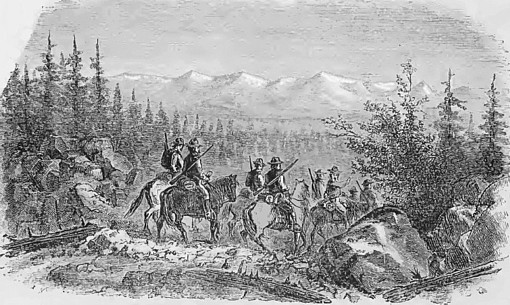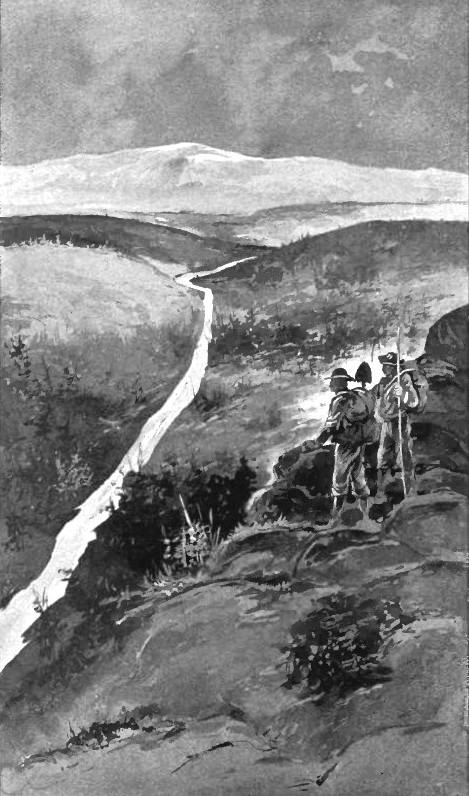It was on the 19th day of January, in 1848, that James W. Marshall, while examining a race way which had been dug for a saw-mill at Coloma, about thirty-five miles eastward from Sutter's Fort, found some pieces of yellow metal. He and the half-dozen men working with him at the mill supposed this metal to be native gold. He felt confident that he had made a discovery of great importance, but he knew nothing of either chemistry or gold-mining, so he could not prove the nature of the metal nor tell how to obtain it in paying quantities. While Marshall never realized any great wealth from that gold, many thousands of men became rich because of that find and the succeeding discoveries that followed. Marshall’s famous discovery transformed California into an "El Dorado," a "land of gold". Men rushed to the gold fields and California became a huge magnet, irresistibly drawing ambitious men from every quarter of the globe. It began a great shift of wealth that moved influence from the old world of Europe to the new world of North America. For roughly 60 years, history regularly repeated itself in the discovery of rich, new gold deposits and the excitement caused by those finds. The late 1800s were an especially intense time for great gold rush stampedes. The residents of the Pacific coast passed through a number of mining excitements beginning with the days of '49, when the great rush to California followed the discovery of gold in that then almost unknown and sparsely inhabited country. For many years after the discovery of gold in California a succession of mining crazes passed over the country, stirring up all those who dreamed of riches until all the country from the Mexican border to icy tundra of Alaska had been explored and found to contain rich mines. From the time of Marshall’s first discovery on the American River to the excitement caused by the Klondike find; gold rush fever swept over the country like a series of tsunami waves.
The Tales of Gold Rush History:
Alaska Gold Rush History
Arizona Gold Rush History
South Dakota
Gold Rush History
California Gold Rush Tales
Colorado Gold Rush History
Nevada Gold and Silver Rush History
Comstock Gold and Silver Rush History
North Carolina Gold Rush History
Australia Gold Rush History
Fraser River Gold Rush History
Klondike Gold Rush History
Idaho Gold Rush History
Montana Gold Rush History
Oregon Gold Rush History
New Mexico Gold Rush History
Washington Gold Rush History
Utah Gold Rush History
Only a few years after Marshall’s find, some California prospectors sailed across the Pacific Ocean and great goldfields were discovered in Australia. This began to turn the tide of gold seekers south to dig gold in the mines of Victoria, Australia. As early as the year 1857, only nine years after the discovery of gold in California, a northward movement along the western coast resulted in the discovery of placer gold on the Fraser River, in British Columbia, and a stampede outward from California resulted. People went wild all over the coast, and flocked in crowds to Victoria, then principally a fort of the Hudson's Bay Company. Most of them had but little idea where the Frazer River was or how they were going to get there. There were no steamers running on the Frazer, nor any for some time from Victoria to the Frazer. All the boats, canoes and dugouts available could only take a few of the people who wanted to go, and they collected in camp at Victoria till there were, it is said, 20,000 people there to celebrate the Fourth of July in 1858, or thereabouts. Deposits of gold were found along the Frazer from fifty miles above the mouth to the Rocky Mountains, some 600 miles distant.
The swarms that invaded California in 1849 also flowed north over into Oregon. Rich diggings were discovered around Jacksonville, and the miners pushed their way up the Columbia into Idaho and Montana, the only route to those remote regions being along the valley of the Columbia. Rich mines were found at Salmon River, Oro Fino and many other places, and in the Bitter Root mountains and farther on into Montana. Other states, like Colorado, Arizona and South Dakota all had their share of gold rush excitements as well. In 1859, the great Comstock gold and silver lode was struck in Nevada and adventurous prospectors swarmed east over the Sierra Nevada to Virginia City and other silver ore boomtowns. The Comstock was the first, but there were many silver rush stampedes. There were also great rushes to find rich copper ore deposits across the US. The pioneers sought whatever was valuable to build civilization and enrich their nation. While that first great gold rush was to the rivers of the Sierra Nevada, the story repeated itself over and over again dozens of times as stampeders moved on to the Columbia and Frazer, and eventually, the Cariboo country. In time many other rivers were invaded as prospectors spread across the west. In 1871 the rich "Caribou" District was discovered, and another excitement ensued, which resulted, in 1874, in the discovery of rich gold-fields in the Cassiar Mountains, both of which districts lie immediately south of the headwaters of the Lewes River. The Cassiar placers were in time exhausted, and the hardy miners pushed on, not directly over the mountains, but later there were rushes to Ominica, Peace River and many other districts.
The march of prospectors continued northward into the wilderness, and more discoveries were made. In 1880, the alluvial gold of Silver Bow Basin was discovered, east of the present town of Juneau, Alaska, which was first known as Harrisburg, in honor of Dick Harris, one of the two original discoverers, but was subsequently changed to Juneau, after Joe Juneau, the other partner. The mines here produced considerable gold, though the majority came from hard rock mines. Not long afterward, pioneer miners pushed up the Yukon River making important discoveries in the 40 mile district near the US border with Canada. A few years later, prospectors exploring the area made the great discoveries of gold nuggets on the Klondike River system. This gold rush changed the face of gold mining and drew wanders from all over the world. It took time, but the Klondike proved its riches to the world as ship after ship loaded with nuggets moved from the Klondike south.
The boom towns of Nome, Fairbanks and a handful of others in Alaska also attracted thousands of men and women who rushed north seeking wealth. The last among those great pioneer finds were made in the early 1900s and in addition to Alaska, include the important lode discoveries at Cripple Creek, Tonopah, Goldfield and the gold mines of Western Australia. Great finds were made afterward at many individual mines, but these were the last of the great gold rushes to new and previously undiscovered districts, with thousands of people blazing forth to seek their fortunes. By 1910, the more important new gold fields had, for the most part, been found and work was underway.
For a little more than 60 years, from 1848 to roughly about 1910, thousands of prospectors regularly flocked toward the fringes of civilization seeking to discover rich streams and mountain veins of copper, silver and gold ore with dreams of glory and new found wealth. While these great gold and silver rushes did produce a few well-earned fortunes, however the majority of gold rush prospectors, after enduring hardships and sufferings, typically returned home poor, nearly naked and hungry. Realizing those dreams of gold rush wealth took hard work, knowledge, skill and in the end, a substantial quantity of good luck. Those men dedicated themselves, took gigantic risks and endured terrible hardships to build not only their own wealth, but that of the nation by creating businesses and providing jobs and profits for hundreds of others. In many ways, their success has given us the high standard of living and comfort that we so well enjoy today.
This webpage is a link to many hundreds of histories and personal stories of those men and women who participated in the many versions of the great western Gold Rush. By the sweat of their brows and hard work of their hands, these men and women settled the west and forged a strong new nation out of a rugged wilderness. Only because we stand upon their shoulders do we enjoy the comforts, community and country which they founded. In spite of the present “politically correct” climate of enviro-facisim, which ignores their pioneer spirit and degrades their efforts as simple greed, the true story of the American prospector and miner deserves not only to be told, but to be celebrated. This webpage was built to celebrate their trials, tribulations and many wonderful accomplishments.


Metal Detectors
For Gold Prospecting:

